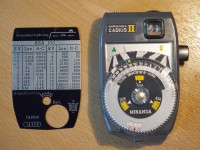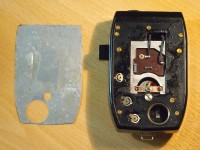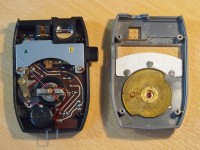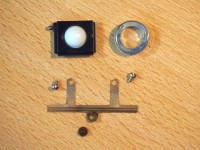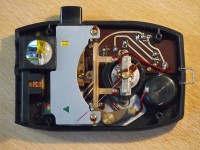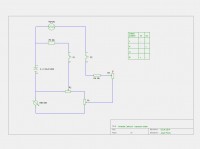Recently, after a lengthy-ish search, I was finally able to acquire a Miranda Cadius II exposure meter, externally in almost “as new” condition. I was told it had been the pride of the seller’s late father, and it really looked like it had been cared for.
Unfortunately, in spite of its good looks, it didn’t work too well. The ‘L‘ (Lock) position was non-functional, and the needle seemed to become stuck occasionally. Considering what I found inside, I suppose it had been either dropped, or bumped about during delivery.
Because the Cadius II was in way too good shape to be left as a show piece only (besides, my older green Miranda Cadius exposure meter wasn’t very accurate, and I needed a working one…), I decided to dismantle it to see whether I could repair it. The glued-in-place metal plate behind the meter needed to be prised carefully out, because all of the screws were behind it.
I was expecting electrical problems, but as seems to be usual for Miranda (and, I suppose, for other make’s camera metering systems of the time), there were very little electrical components inside, but instead a load of ingenious mechanical solutions.
The culprit for the malfunction was the little red plastic knob shown in the picture below. It had come off from its place at the center of the ‘π’-shaped needle ‘brake’, and had been jumping around the meter in all the wrong places. It was easy enough to glue it back. The assembled needle brake is shown in the next picture.
For reference, I also drew a schematic of the electrical circuit of Cadius II.
I have been cross-testing the Cadius II with the built-in exposure meters of my cameras, both film and digital, and with an iPhone exposure meter app, and it seems that the Cadius II is still a very accurate meter, especially considering its age of some 40+ years…

